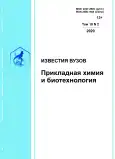Effect of nodule and pathogenic bacteria on levels of nitric oxide and cyclic adenosine monophosphate in pea roots at initial stages of interaction
- Authors: Ishchenko A.A.1, Filinova N.V.1, Sidorov A.V.1,2
-
Affiliations:
- Siberian Institute of Plant Physiology and Biochemistry SB RAS
- Irkutsk State Medical University
- Issue: Vol 10, No 2 (2020)
- Pages: 294-302
- Section: Physico-chemical biology
- URL: https://bakhtiniada.ru/2227-2925/article/view/299684
- DOI: https://doi.org/10.21285/2227-2925-2020-10-2-294-302
- ID: 299684
Cite item
Full Text
Abstract
About the authors
A. A. Ishchenko
Siberian Institute of Plant Physiology and Biochemistry SB RAS
Email: aspt25@yandex.ru
N. V. Filinova
Siberian Institute of Plant Physiology and Biochemistry SB RAS
Email: Filinova@sifibr.irk.ru
A. V. Sidorov
Siberian Institute of Plant Physiology and Biochemistry SB RAS; Irkutsk State Medical University
Email: a.v.sidorov@ismu.baikal.ru
References
- Beatly P.H., Good A.G. Future prospects for cereals that fix nitrogen // Science. 2011. Vol. 333. Issue 6041. P. 416–417. https://doi.org/10.1126/science.1209467
- Проворов Н.А., Воробьев Н.И. Генетические основы эволюции растительно-микробного симбиоза. СПб: Изд-во ООО «ИнформНавигатор», 2012. 400 с.
- Колупаев Ю.Е., Карпец Ю.В., Ястреб Т.О., Луговая А.А. Сигнальные посредники в реализации физиологических эффектов стрессовых фитогормонов // Вестник Харьковского национального аграрного университета. Серия Биология.
- Вып. 1 (37). С. 42–62.
- Глянько А.К., Ищенко А.А. Активные формы кислорода и азота – возможные медиаторы системной устойчивости у бобовых при действии ризобиальной инфекции // Вестник Харьковского национального аграрного университета. Серия Биология. 2017. Вып. 1 (40). С. 9–20.
- Djordjevic M.A., Gabriel D.W., Rolfe B.G. Rhizobium-The Refined Parasite of Legumes // Annual Review of Phytopathology. 1987. Vol. 25. P. 145–168. https://doi.org/10.1146/annurev.py.25.090187.001045
- Baron C., Zambbryski P.C. The plant response in pathogenesis, symbiosis, and wounding: variations on a common theme? // Annual Review of Genetics. 1995. Vol. 29. P. 107–129. https://doi.org/10.1146/annurev.ge.29.120195.000543
- Glyan'ko A.K., Ishchenko A.A. Immunity of a leguminous plant infected by nodular bacteria Rhizobium spp. F.: review // Applied Biochemistry and Microbiology. 2017. Vol. 53. Issue 2. P. 140–148. https://doi.org/10.1134/S0003683817020107
- Meilhoc E., Boscari A., Bruand C., Puppo A., Brouquisse R. Nitric oxide in legume-rhizobium symbiosis // Plant Science. 2011. Vol. 181. Issue 5. P. 573–581. https://doi.org/10.1016/j.plantsci.2011.04.007
- Baudouin E., Pieuchot L., Engler G., Pauly N., Puppo A. Nitric oxide is formed in Medicago truncutula – Sinorhizobium meliloti functional nodules // Molecular plant-microbe Interactions. 2006. Vol. 19. Issue 9. P. 970–975. https://doi.org/10.1094/MPMI-19-0970
- Herouart D., Baudouin E., Frendo P., Harrison J., Santos R., Jamet A., et al. Reactive oxygen species, nitric oxide and glutathione: key role in the establishment of the legume-Rhizobium symbiosis // Plant physiology and biochemistry. 2002. Vol. 40. Issue 6-8. P. 619–624. https://doi.org/10.1016/S0981-9428(02)01415-8
- Meyer C., Lea U.S., Provan F., Kaizer W.M., Lillo C. Is nitrate reductase a major player in the plant NO (nitric oxide) game? // Photosynthesis research. 2005. Vol. 83. P.181–189. https://doi.org/10.1007/s11120-004-3548-3
- Lomovatskaya L.A., Kuzakova O.V., Romanenko A.S., Goncharova A.M. Activities of Adenylate Cyclase and Changes in cAMP Concentration in Root Cells of Pea Seedlings Infected with Mutualists and Phytopathogens // Russian Journal of Plant Physiology. 2018. Vol. 65. Issue 4. P. 588–597. https://doi.org/10.1134/S1021443718030056
- Kuzakova O.V., Lomovatskaya L.A., Goncharova A.M., Romanenko A.S. Effects of Rhizobium leguminosarum bv. viceae strains different in their symbiotic effectiveness on changes in cAMP and hydrogen peroxide concentrations in cells of pea seedlings // Russian Journal of Plant Physiology. 2019. Vol. 66. Issue 5. P. 712–717. https://doi.org/10.1134/S1021443719050121
- Lomovatskaya L.A., Romanenko A.S., Filinova N.V., Dudareva L.V. Determination of cAMP in plant cells by a modified enzyme immunoassay method // Plant Cell Reports. 2011. Vol. 30. Issue 1. P. 125–132. https://doi.org/10.1007/s00299-010-0950-5
- Jones K.M., Sharopova N., Lohar D.P., Zhang J.Q., VandenBosch K.A., Walker G.C. Differential response of the plant Medicago truncatula to its symbiont Sinorhizobium melliloti or an exopolysaccharide-deficient mutant // Proceedings of the National Academy of Sciences of the USA. 2008. Vol. 105, Issue 2. P. 704–709. https://doi.org/10.1073/pnas.0709338105
- Ferguson B.J., Indrasumunar A., Hayashi S., Lin Y.-R., Lin Y.-H., Reid D.E., et al. Molecular analysis of legume nodule development and autoregulation // Journal of Integrative Plant Biology. 2010. Vol. 52. P. 61–76. https://doi.org/10.1111/j.1744-7909.2010.00899.x
- Gough C., Jacquet C. Nod factor perception protein carries weight in biotic interaction // Trends in Plant Sciences. 2013. Vol. 18. Issue 10. P. 566–574. https://doi.org/10.1016/j.tplants.2013.06.001
- Глянько A.К. Фитогормоны и клубенькообразование у бобовых растений // Вестник Харьковского национального аграрного университета. Серия Биология. 2015. Вып. 3 (36). С. 6–19.
- Hichri I., Boscari A., Castella C., Rovere M., Puppo A., Brouquisse R. Nitric oxide: a multifaceted regulator of the nitrogen-fixing symbiosis // Journal of experimental botany. 2015. Vol. 66. Issue 10. P. 2877–2887. https://doi.org/10.1093/jxb/erv051
- Глянько А.К., Митанова Н.Б., Степанов А.В. Физиологическая роль оксида азота (NO) у растительных организмов // Журнал стресс-физиологии и биохимии. 2009. Т. 5. N 3. С. 33–52.
- Courtois C., Besson A., Dahan J., Bourque S., Dobrowolska G., Alain P., et al. Nitric oxide signaling in plants: interplays with Ca2+ and protein kinases // Journal of Experimental Botany. 2008. Vol. 59. Issue 2. P. 155–163. https://doi.org/10.1093/jxb/erm197
- Jeandroz S., Lamotte O., Astier J., Rasul S., Trapet P., Besson-Bard A., et al. There’s more to the picture than meets the eye: nitric oxide cross talk with Ca2+ signaling // Plant Physiology. 2013. Vol. 163. Issue 2. P. 459–470. https://doi.org/10.1104/pp.113.220624
- Глянько А.К. Роль Nod-фактора Rhizobium в индукции сигнальных систем растения при формировании бобово-ризобиального симбиоза // Вестник Харьковского национального аграрного университета. Серия Биология. 2014. Вып. 3 (33). С. 6–14.
Supplementary files









